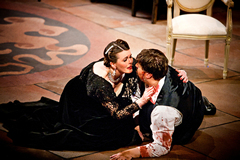| Opera Reviews | 26 April 2024 |
Anthony Besch's production returns like an old friendby Catriona Graham |
|
| Puccini: Tosca Scottish Opera Edinburgh Festival Theatre May 2012 |
|
|
Besides, Anthony Besch's 30-year old Scottish Opera production (revived by Jonathan Cocker) is like an old friend. I recognise Peter Rice's marble columns in the church, the wrought iron gate into the chapel. In Act 2, I recognise the table set for Scarpia's supper, the fireplace and the deep windows of the Palazzo Farnese. Paul Carey Jones as Angelotti is justifiably twitchy, having just escaped from Castel Sant'Angelo. Jose Ferrero's Cavaradossi calms him slightly, offering first food then a refuge to a man he admires. No sooner has Angelotti been hidden and Cavaradossi returned to his painting than his lover, the singer Floria Tosca arrives. And a right diva she is, too. Susanna Glanville wears a black fur coat with a white shawl collar and jealous green dress with matching gloves. She is suspicious - or is it only affectation? And all that stuff about 'not in front of the Madonna'? Hm. It is a compliment to say that Robert Poulton's voice sounds false when, as Scarpia, what he is singing is false. He is manipulative and calculating, obviously - no man would be in his position at that time (the production is set in 1943, after all) if that were not the case. It takes him no time at all to charm (smarm?) the information he needs from Tosca, a woman who probably has never given a moment's thought to the political situation beyond her own comfort. And yet … In the second act, after Cavaradossi has been arrested and taken off for 'questioning', Tosca arrives, all black 'n' bling from her performance. Gone is the jealousy of the church; now Tosca is concerned to spare her lover any further pain. Yet she is still naïve - she takes Scarpia at his word, when he signs the safe conduct, and sees no sub-text in his instructions about Cavaradossi's execution. That is not why she stabs and kills Scarpia the moment he tries to embrace her - she is cheating on her side of the 'bargain' she thinks she has struck. Even on the battlements of the Castel Sant'Angelo, seeing the execution squad, she still thinks she has a deal. The realisation that she hasn't, that she has been naïve in trusting Scarpia, and that his death has been discovered, leaves her only the option to take her own life. The singing is excellent, even in the smaller parts - Marie Claire Breen is a bell-like Shepherd Boy at the start of Act 3. Glanville and Ferrero blend nicely in their duets and Glanville does full justice to her big arias. Meanwhile, in the pit, Francesco Corti and the orchestra fill the theatre with Puccini's big sound. One quibble would be to note that dawn comes much earlier through the windows in Scarpia's room at the Palazzo than it comes to the battlements of the Castel. Still, as Tosca found, we can't have everything … |
|
| Text ©
Catriona Graham Photo © Mark Hamilton |

 I'd
forgotten how a-melodic the start of Tosca is, when Angelotti rushes
into the church of Sant' Andrea della Valle, seeking the key for the
Attavanti chapel, and how it contrasts with the jaunty music for the
Sacristan who comes in to do the dusting.
I'd
forgotten how a-melodic the start of Tosca is, when Angelotti rushes
into the church of Sant' Andrea della Valle, seeking the key for the
Attavanti chapel, and how it contrasts with the jaunty music for the
Sacristan who comes in to do the dusting. 





